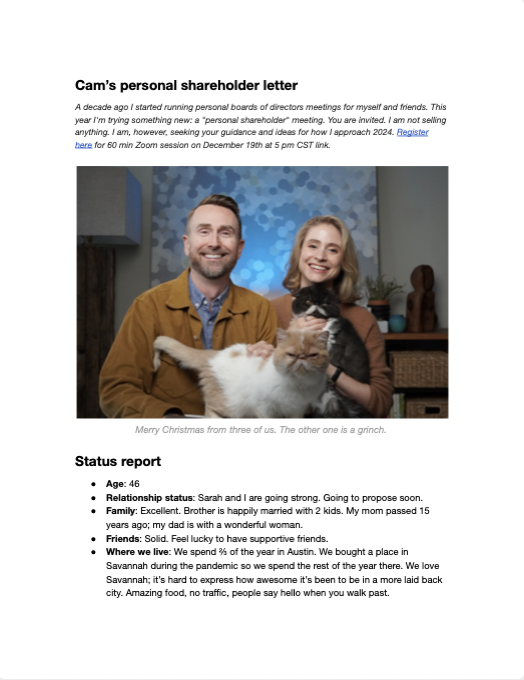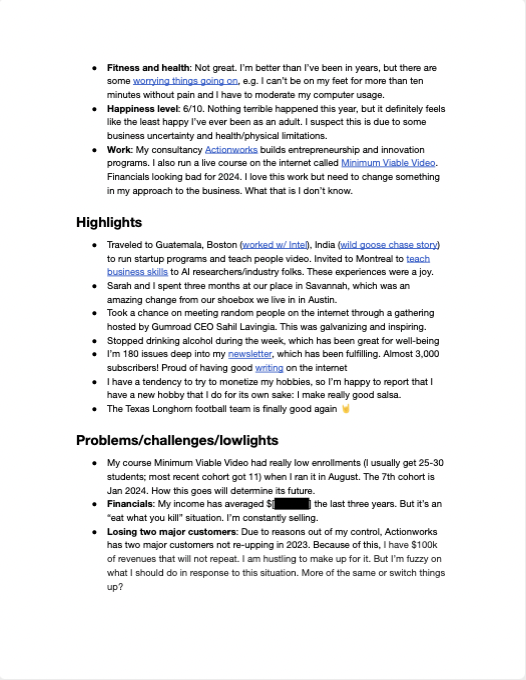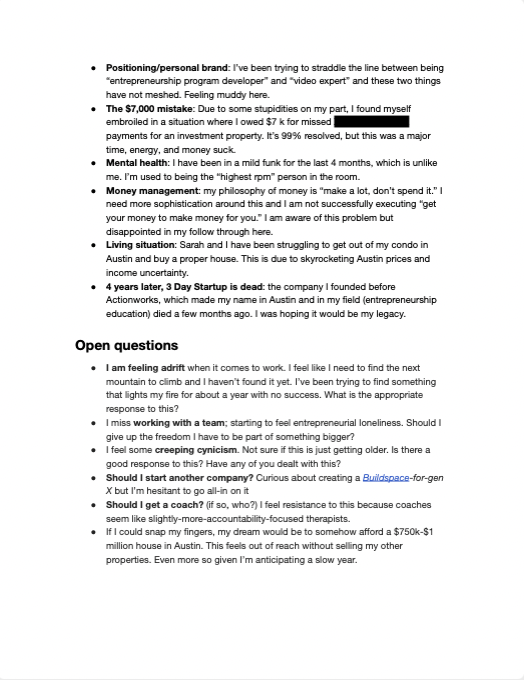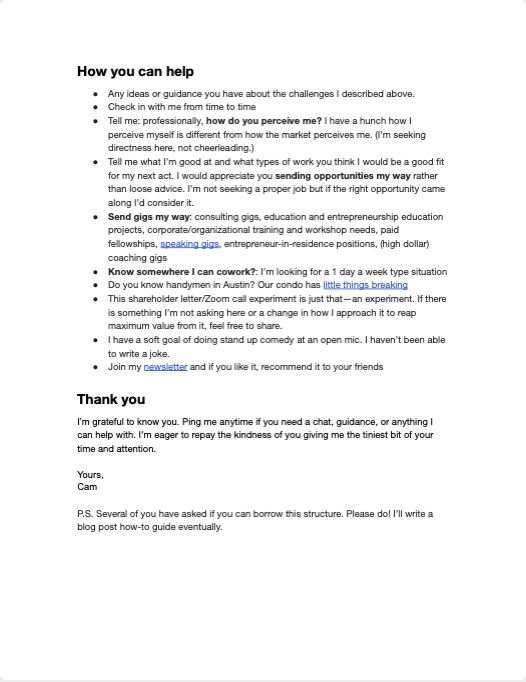TL;DR: Write a “shareholder letter” to friends and acquaintances, share it two weeks before you host a gathering in Zoom, and capitalize on the ideas, conversations, and opportunities that emerge. Time required to put this in action: 2-3 hours.
I’ve been in a funk for the last four months. I’m not sure if it’s because I lost two major clients ($100k of revenues…gone), creeping cynicism, or I’m just getting older.
Either way, life’s colors seem duller and 2024 was not shaping up well.
But I turned things around using a structure borrowed from the world of business. This approach made it easier for the people in my life to help me solve my problems. Thanks to this exercise, I now have:
- Two job offers
- Eight introductions to potential collaborators
- The insight that the answer to my entrepreneurial loneliness might be to get a job under a great boss (this might be obvious to y’all. But I’ve been a founder for 13 years)
- Three places to cowork for free
- Clarity on the type of projects I want to work on
- Leads on specialists regarding some health issues
- A renewed sense of purpose
In this piece, I’ll share the results of the experiment that got me unstuck and created positive momentum for the future.
A shareholder meeting…for a person
Companies regularly host annual shareholder meetings, which is a gathering where individuals who own stock in the company come together to discuss the company’s operations, strategies, and future plans. The company shares what matters: performance (financial and otherwise), progress towards goals, important upcoming decisions, and risks for the future.
A personal shareholder meeting is the same…but for a person.
(Aside: this is not my first experiment along these lines; it’s a variation on Personal Board of Directors Meetings (how-to guide), a structure I’ve been perfecting over the last decade. This practice morphed an annual drinking-focused retreat into revitalized friendships and an overwhelming sense that my friends are fired up for each member of the group to succeed. It involves getting the people closest to you to meet in-person for a weekend and taking a structured approach to solving each other’s problems. Wildly powerful, but a heavy lift in terms of planning and logistics.)
A personal shareholder meeting is much easier to run. First off, it happens in Zoom, which means you’re not asking the people in your life to buy flights and hotels. Second, you cast a wider net. A company only has ten or so board members. But a company can have hundreds, thousands, or millions of shareholders. You don’t have to limit invitations to your ride-or-dies. Here’s the criteria I used for the people I invited:
- a friend or family member
- a colleague or acquaintance I think is cool
- someone whose work I respect
Don’t overthink who you will invite. You’ll forget key people and several people you invite won’t be up for this. If you’re on the fence about inviting someone, do so. Some of the best advice I got came from people I almost didn’t feel comfortable inviting.
Including people beyond your inner circle opens up access to different perspectives. And data shows that when it comes to creating opportunities in your life, weak ties matter just as much as strong ties.
What’s important is that you are emailing anywhere from ten to hundreds of people to show up in Zoom and think about your problems for an hour.
…But that feels weird
It may feel strange or narcissistic to run an experiment like this. I get it. Gathering people from different parts of your life where you are in the spotlight can feel intimidating. I have college friends, bandmates from my musician days, tech startup and internet communities, random colleagues who I felt a connection with. Getting them together for the sole purpose of focusing on me makes me feel like a diva.
Here’s how to get over that feeling:
The people in your life want to help
If you try to be a generally decent person—you help out when asked, you try not to be a burden on those around you, and you don’t make enemies everywhere you go—the people in your life won’t be on the fence about agreeing to participate. Rather, they will feel grateful to have an opportunity to support you. They will feel honored you asked. You’ll realize that much of your life you’ve been accruing a social debt that you have not been giving people an opportunity to repay. People will actually feel happy that you included them in this process. (NB: If you are a serial taker and/or narcissist, consider working on yourself before you attempt a shareholder meeting).
Have fun with the concept of a shareholder
Just because you are borrowing a structure from the world of business does not mean you can’t have fun with it. Your shareholders will appreciate it.
My friend Zakk ran a personal shareholder meeting and proudly told the attendees that a share of him was worth the price of a Costco hotdog (i.e., $1.50). The faces in the Zoom grid smiled when he cracked this joke and it let the room know that we didn’t need to take this process too seriously.
I quipped that my personal shareholders would receive shares of a cryptocurrency named after my cat Pinky:
The joke itself—and whether it’s funny or not—is not important. What matters is that adding some lightheartedness to the process works like an icebreaker before jumping into the challenges.
Step 1: Write the shareholder letter
The most important part of this practice is not the meeting. It’s the shareholder letter that you send out two weeks before. The shareholder letter sets the frame about where you are in life and what you need help with.




Writing this letter requires self-reflection. It’s powerful how it forces one to confront what’s really going on in your life. Journaling has never really clicked for me. What makes the shareholder letter different is that it will be seen by others. When I sent out the document for feedback, I knew I was asking for a precious commodity—the attention of people I care about. Knowing they were giving me their time and attention put some pressure on me to not waste the opportunity and make the letter clear and true.
My shareholder letter had these sections:
- Status update (the basics: age, relationship status, work situation)
- Highlights (wins for the year, accomplishments I’m proud of)
- Challenges/problems/lowlights
- Open questions (things I’m concerned about)
- How you can help (specific and non-specific asks, ranging from leads to work opportunities to contractor recommendations to coworking suggestions)
My friend Zakk used these sections:
- Recap of last year
- Goals for this year
- Open questions
Obviously you don’t need to follow either of these structures. But if it’s helpful to you, feel free to copy it wholesale. Nailing the structure is less important than the act itself. The mere act of writing this letter crystallized my thinking and let me know that I may not be prioritizing my challenges as well as I thought I was.
I strongly recommend you include a picture. After all, this is a personal shareholder. Remind people what you look like.
The comments in the letter gave me perspectives and created collisions of ideas. If you want to see an example of a fully marked up shareholder letter, here is mine.
Step 2: Invite people
I recommend you keep the invitation email short and sweet with a brief introduction to the process.
Here’s the email I sent to get people involved. I emailed about 50 people, all through bcc, and I included a short summary at the top.
I was surprised at how many sparks the shareholder letter created. I felt overwhelmed—in a positive sense—by the comments in the doc and the responses to my email.
Step 3: Host the meeting
The meeting is when you’ll gather people together to get their takes. After some warm hellos, I kicked it off and recapped the shareholder letter I sent out to refresh people’s memories and inform those who never read it.
Outline:
0:00 — Welcome and introduction
0:05 — Recap the letter or share what’s on your mind
0:25 — Open the floor for questions
0:50 — Thank you and closing remarks
Host the meeting at a time when you think your shareholders can make it. 8:00 pm on a Monday or Tuesday is a generally safe bet: that time does not conflict with work meetings, dinner time, and kids’ bedtimes. Attendance will be lower than you think, which is fine: the people who want to help will leave comments in the shareholder doc or respond to your email.
Keep the session to 60 minutes. I used a slide deck with a very simple agenda to add some structure:
Step 4: Follow on activities
You know how when you attend a conference, the most valuable part is the interactions and conversations end up being more valuable than the “main event” keynotes, panels, and speakers?
The meeting part of the personal shareholder meeting is the same. I found that the follow-on conversations, coffee meetups (people on your list will suggest coffee or, at minimum, be open to it if you ask). The exchanges that occurred after releasing the doc and holding the meeting were where the magic happened.
My explanation for this is that the document was easy for them to read and digest and it put me top of mind. Some of these people I hadn’t seen in months or years. But reading my letter reminded them I exist, and even more helpfully, let them know the challenges I was facing.
What Next?
Finally, send a personalized thank you to everyone who attends. The intent here is to show gratitude and appreciation, but as is common when you express gratitude, people end up sharing more ideas and support.
All that remains is to capitalize on the momentum. When I ran this experiment, I was convinced that I needed solutions to problems—not cheerleading and encouragement. But nonetheless, encouragement rolled in and I found my outlook brightened. Maybe I needed encouragement and support more than I thought I did.
But the real-world progress felt undeniable. There is a direct line between running a personal shareholder meeting and conversations that led to:
A new take on my next act: I’ve been a founder so long that my mindset had drifted to a place where I thought that if I wanted to work with great people I’d need to start another company and build the team myself. Now I’m actually excited about the prospect of getting a job.
Free coworking: Working at friends’ offices a couple of days a week has done wonders for my output. Three people offered to host me—apparently a lot of people work for companies with extra office space.
“Supercharged” coffee meetups: Like a lot of people exploring open questions about their future, I’ve been asking friends for advice over coffee. Sending the personal shareholder to them in advance got their wheels turning on what was important to me before we even met up. Often the first thing that happened during these meetups was them offering a torrent of ideas and options to consider.
Sleeper agents for the self: Something I’m still in awe of is how such a simple process has created a situation where dozens of people are giving just a little bit of brainpower to my goals, my work, and what I’m chasing. This has been great in terms of the opportunities it has brought my way, but it’s wildly motivating to know that this many people are invested—however small the dose—in my well-being.
Even more positive outcomes emerged from this process, whether it was invitations to collaborate on projects together or job offers or just making
If you run one of these, I can’t say what you will get out of it. But I guarantee it will be good.
Get weekly tips on entrepreneurship, video, and shooting your shot in my newsletter: https://www.camhouser.com/newsletter
SO to early readers Zakk Fleischmann, Mitchell Cohen, Alan Hibbard, Aleena Vigoda
